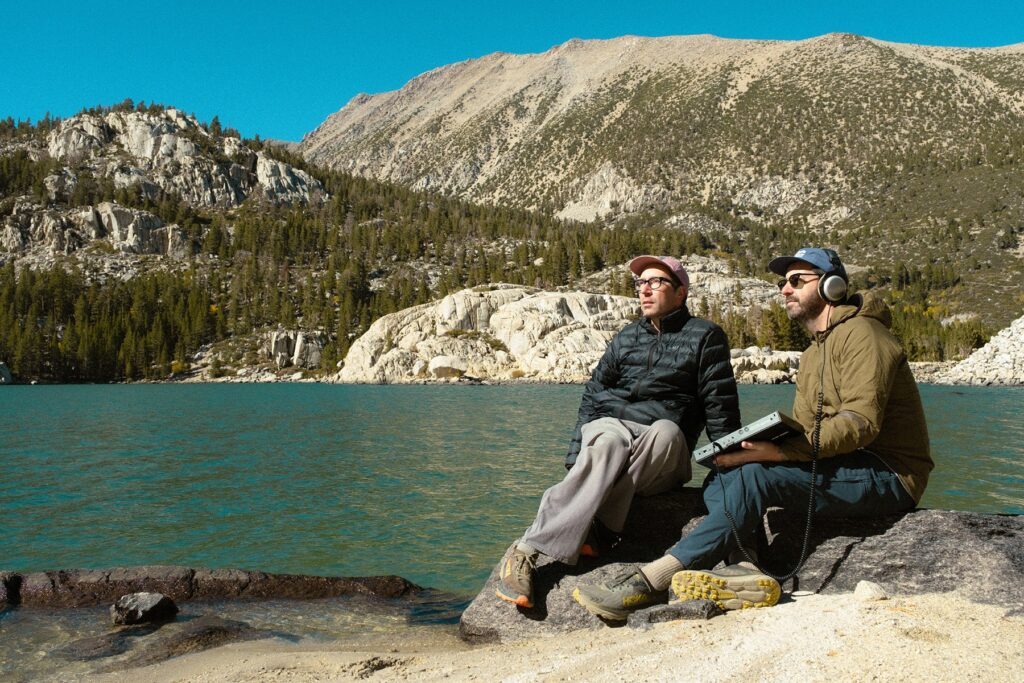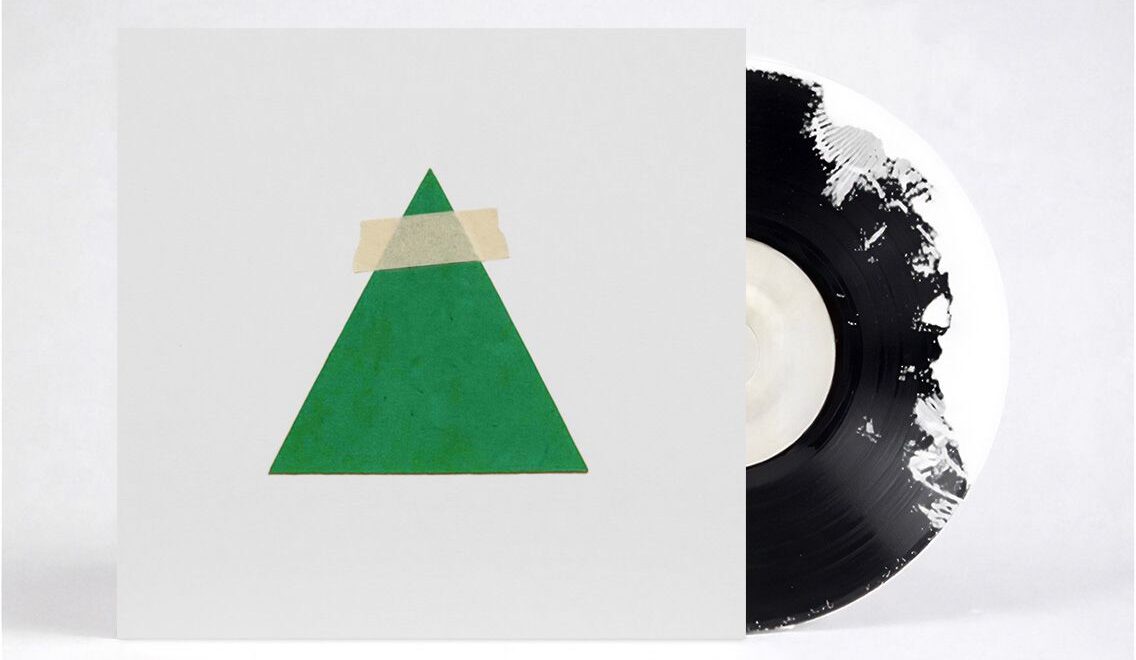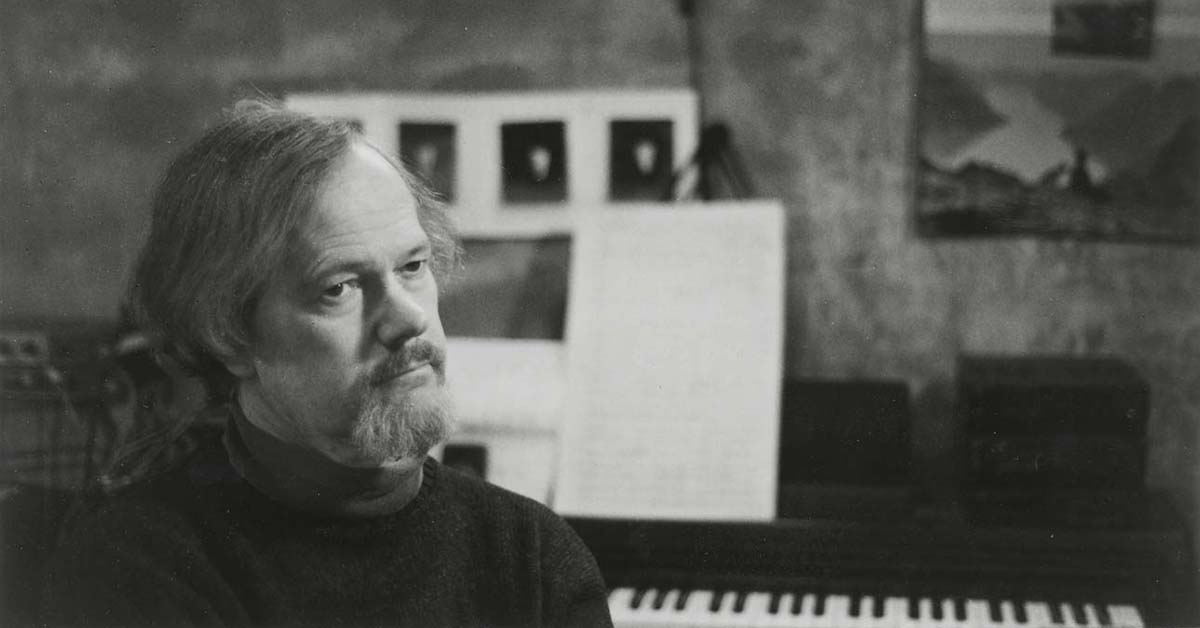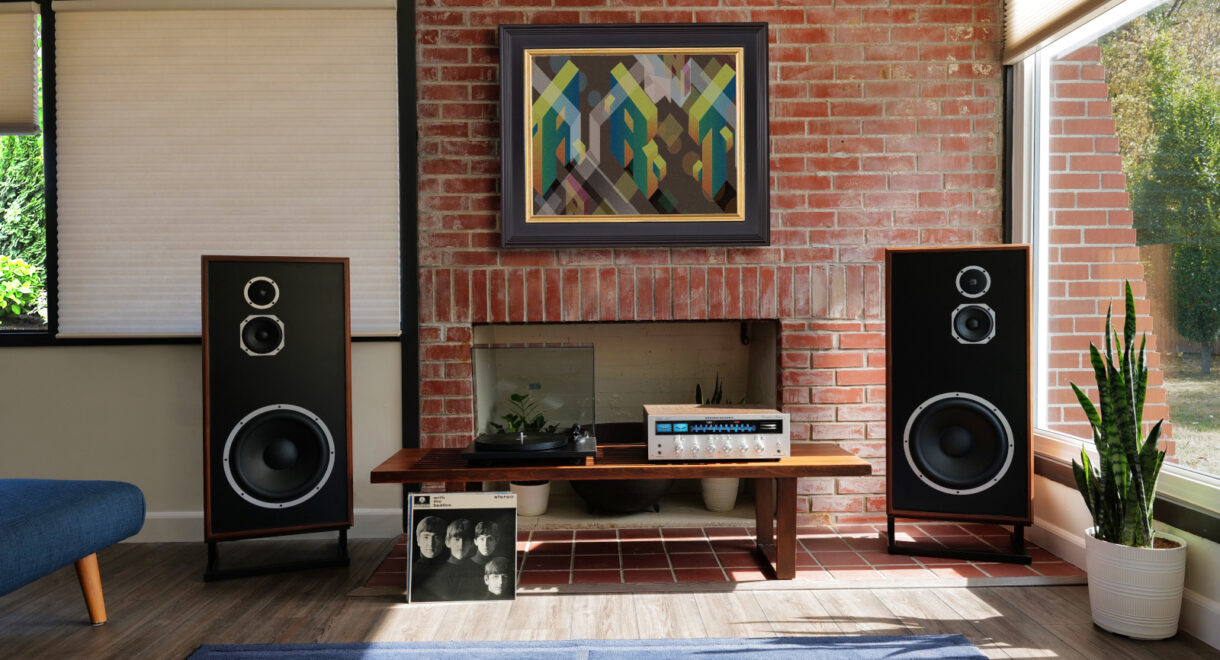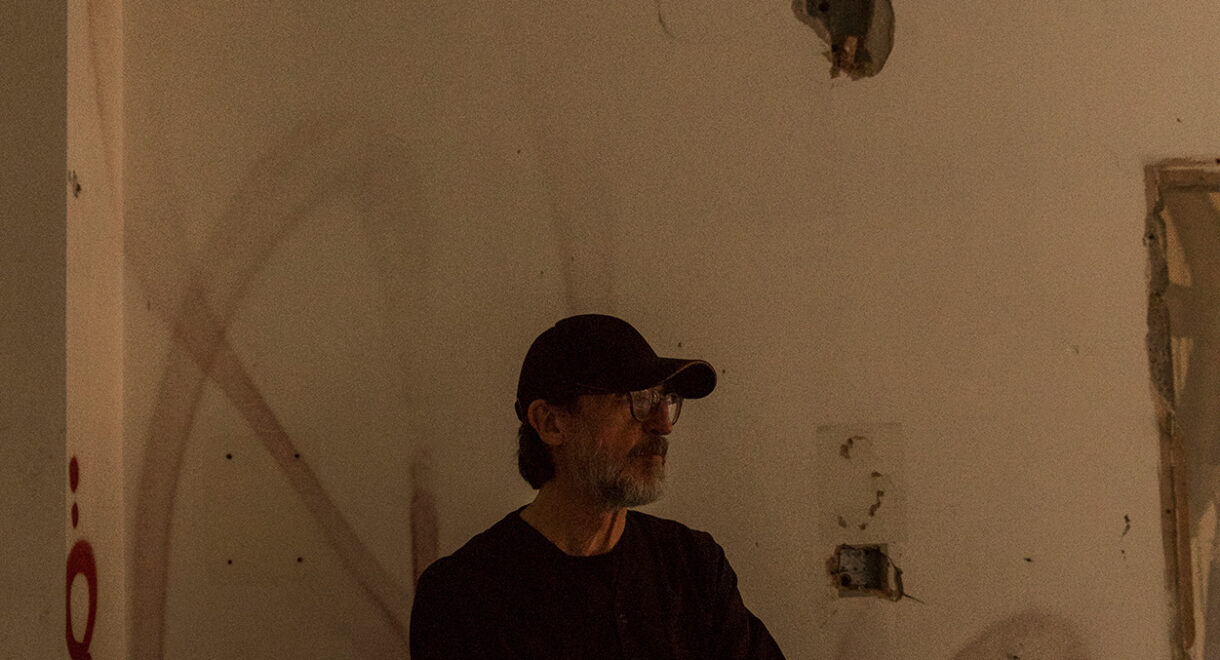Merry cosxmes to all those who celebrate! It’s that time of year again… That’s right — another cosxmes mix has been uploaded! In certain circles, “cosxmes” is the […]
Highland Park Sleep Collective: Listening Room No. 2

Originally composed for Devon Ojas’ Listening Room Dream No. 2, Highland Park Sleep Collective’s latest album is an ambient trip through ultrasonic frequencies and audiophile listening.
Longtime friends and collaborators Filip Nikolic and Tim Anderson have carved out their own unique paths in the music industry. Originally emerging from the ’00s era indie scene in Los Angeles, the pair have produced for major artists like Billie Eilish, Pabllo Vittar, Solange, and King Princess, composed for film & TV, and now operate their own record labels. Nikolic runs the archival South Asian diasporic imprint Naya Beat with Raghav Mani, while Anderson heads up the sustainable vinyl label and manufacturer Good Neighbor alongside Scotty Coates.
They’re also obsessed with sound. A few times a year, the duo travels to various nature sites and gathers sounds to be used for their Highland Park Sleep Collective project. Inspired by Daniel Lanois, Harold Budd, and Brian Eno, the duo creates ambient music at the intersection of nature and electronics. Thunderstorms, campfires, rain water, and other natural sonic wonders blend with Nikolic and Anderson’s deep well of electronic equipment, which includes everything from massive modular racks to vintage synths to cheap toy keyboards.
Highland Park Sleep Collective’s latest album, Listening Room No. 2, was composed specifically with hi-fi listening in mind. Featuring recordings from an ultrasonic microphone that captures well beyond human hearing capability, the album hones in on the sublime auditory experience of listening, and was premiered at Devon Ojas’ San Francisco MoMa Exhibit Listening Room Dream No. 2. The album is out tomorrow and is available now for pre-order via In Sheep’s Clothing Distribution. Shops can reach out to [email protected] for wholesale.
In anticipation of the release, In Sheep’s Clothing’s Phil Cho spoke with Nikolic and Anderson at their studio in Highland Park to learn more about the origins of the project, field recording, ultrasonic frequencies, favorite hi-fi tracks, and more!
Where does the name Highland Park Sleep Collective come from? I can kind of formulate an idea, but I'm curious about the actual origins.
Filip: Stepping back a bit, in the ‘00s I was playing in Junior Senior, and we were on tour with Timmy’s band IMA ROBOT. We became friends, and once the tour was over, I decided to stay in LA because I had an O-1 Visa. Later, I’m A Robot had an opening for a keyboard / rhythm guitar player, so I auditioned and joined the band. Years after I’m A Robot wasn’t happening anymore, Timmy had kids and it basically got to the point where we wouldn’t see each other very often even though we were really close friends. Then we somehow found out that Timmy, his kids, and I actually shared something in common: we’re all total insomniacs. Timmy and his kids were using all sorts of different audio to help them sleep, and at the time I was listening to this one thunderstorm album on repeat every night. We talked about this and thought, “Since we all have this common problem, why don’t we make our own solutions to that?” That’s when the idea of Highland Park Sleep Collective came together.
T: To help my daughter fall asleep, we would listen to whatever was available at the time. It was probably some long playlist of sleep music, but I found the playlist to be inconsistent as far as quality. I remember saying to Filip, “I think we could do this better.” We both loved ambient music. I was always obsessed with The Pearl by Brian Eno, Harold Budd, and Daniel Lanois. I would listen to it all the time because it helped me through my fear of flying. Then Filip and I bonded over sleep music and realized that what was out there was good, but maybe not perfect. So we set out to work together on that.
You mentioned the sleep playlist being inconsistent. What elements or qualities do you tend to look for in music that’s effective for sleep?
F: The music shouldn’t have too many dynamics and should be kept linear. A lot of ambient music actually doesn’t work well for sleep because they include really slow gnarly builds into something. You should be able to just put on, and not have too many surprises.
T: It shouldn’t bring you out of the dream. It’s funny that Filip was obsessed with the thunderstorm album because the first thing that annoyed me about that playlist my daughter and I listened to was that most of the music was very calm, a few chords, running water, etc. but then all of a sudden a thunderstorm came on. It really upset me because three hours in when I was finally falling asleep, that came on and totally broke me out of it. It got me thinking about all the different categories of ambient music, and how we could participate in the space.
Field recording and sound gathering also seems to be a key part of this project, along with adventure and interacting with nature. You’re both instrumentalists and producers by trade, when did field recording become a part of your musical practice?
F: When Timmy got married around 20 years ago, he invited some friends on a backpacking trip as his bachelor party. None of us really knew what we were doing. I was wearing jeans and a pair of Vans, and we got caught in a snowstorm. It was really hectic because we were too high up and we couldn’t easily go back. We made it down the mountain the next day, and it was like, “Oh my God, this is the craziest and most awesome trip ever.” Timmy started doing that backpacking trip annually. After a while, it just made sense to bring recording into that. We loved being in nature, so why not harvest some of those sounds? For our first HPSC field trip, we rented a cabin in Big Bear for the weekend and recorded a bunch of creeks and stuff. We also studied all the weird sub-branches of ambient music, conspiracies around frequencies, 432 Hz, and all that. It was such a fun weekend just recording, and that’s where it all started.
T: It’s been almost 10 years now. That was our first sound gathering. It’s interesting, the sounds that were the best probably weren’t even the ones we expected like rain captured from inside of the car, or the fireplace in the cabin. We were recording everything we could, and then there are certain things that become rare gems. Those recordings became the first HPSC album.
“I grew up surrounded by hi-fi audio. My dad was obsessed with audiophile gear, so I’ve heard it all. When that opportunity came up, I thought, ‘Let’s make a record that would be perfect for audiophile listening.'”
Filip Nikolic
Alongside nature sounds, electronics are also a key part of this project. Can you talk about that side and the interaction between nature and the synthesizers and electronic instruments you use?
F: There was a time we were doing all sorts of weird experiments with water. We realized that with modular synthesizers, it’s actually not hard to create that same randomness. Most natural sounds are consistent when you look at them from the outside, but when you narrow in, it’s as random as it gets. Natural white noise is the most random sound source you can get. On the first two albums, there were a lot of modular synthesizers where the sounds are trying to be like nature. I don’t think there was that much thought put into it, but more like, “this instrument can actually do something that sounds like what we just recorded.” That’s the fun part.
T: It’s always interesting listening to a field recording and trying to understand what’s really happening, what it feels like, or if there’s a pattern, and then trying to figure out the right little jam of music over it. It’s so fun when it connects because the sounds of nature are just the greatest. Nature sounds are already perfect. We take a pretty simple, minimalist approach of putting these elements over these recordings, but we know when it feels right, and that’ll be the song. There are a lot of ways you could screw it up and for it not be pleasing at all.
F: For me personally, going back to sleep again, if it’s too smooth and linear, then I still get my weird loopy thoughts. I always have some song stuck in my head, maybe one line or a chorus just again and again. That’s what I’m always trying to distract from. If it’s too linear, like just a creek or something, then it becomes too far away, and I get back to my thoughts. For me, those tiny interruptions help to snap me out of whatever is going on in my head. That’s where synths come in because you can make it a little more musical and create little moments that are distracting enough to where you’re still relaxing, but are able to stop those thoughts.
Can you talk to me about the process of recording this album, in particular? It seems there was a different concept involved than previous albums.
T: This album really has two lives. The first idea: Filip and I were talking about the range of what we hear as humans because there are these ultrasonic microphones he’d become interested in that record up to 100 kHz. They’re typically used in sound stages and film, but it got us curious about what was in those frequencies. We’re not hearing it, but nature provides it, and animals are probably hearing it. We just wanted to know what was in there.
F: I was fascinated by the microphone, and a little disappointed in how people had been using it so far. The human hearing range is roughly 20 to 20,000 Hz. Mine is probably not more than 14 kHz or something. The idea that this microphone can record up to 100 kHz is so interesting. The only thing I really heard people use this microphone for was just really good recordings, or you can slow it down like crazy without getting digital glitching because the resolution is so high. Our idea was to see what happens if before you slow it down to human hearing range, you delete all the material that humans can already hear. We can do a hard cut filter up to 20 kHz, and then everything else would be ultrasonic. Then you start slowing that down and see what’s in there. That was the experiment part of it.
It wasn’t as rewarding as we were hoping. There were no secret messages or animal communications. What we did find was actually a lot of weird interference of stuff that seemed human made, like satellites and cell phones. It’s a really expensive microphone, so we only had a limited amount of time to record with it in Mount Baldy.
T: But then we also got some incredible sounds just messing around in the hotel with dripping water and La Croix, which had this explosive bubbly sound that made it onto the album and sounds almost like a whale breaching. There might even be a human breath in there pitched down. We were just doing weird experiments that sounded incredible when you listened through headphones. It became even more interesting, just not what we were originally expecting.
Then cut to a year or two later, we were asked by Devon Turnbull to participate in his San Francisco MoMa Exhibit, Listening Room Dream No. 2, which was this amazing hi-fi listening room experience he designed as part of the MoMa’s Art of Noise exhibit. Filip and I then had the idea of making something specifically for vinyl pressed through Good Neighbor, a sustainable vinyl manufacturing company that I run with Scotty Coates, that would be a real sonic exploration.
“Steve Albini and Bob Weston actually worked with our team at Good Neighbor, and loved the sound of the records. They were seeing that you could get a little more stereo width out of the low-end.”
Tim Anderson
F: I grew up surrounded by hi-fi audio. My dad was obsessed with audiophile gear, so I’ve heard it all. When that opportunity came up, I thought, “Let’s make a record that would be perfect for audiophile listening.” We had all these extremely hi-fidelity 32-bit 192 kHz recordings from the Mount Baldy trip. The recordings were insane by themselves, but it was fun to use those and try to make something that was maybe not even all musical, but would tickle your hair when you listened through that system. As an audio engineer, one of the challenges was understanding what are the things that sound good when you listen to music on an audiophile system. One interesting thing we did is that there’s zero compression on the record. It’s not mastered, only mixed. The dynamics and transients are out of control, which you can really only hear when you play it on a system that’s fast enough. This time, it wasn’t about sleep, but exploring how we can make something that sounds the best on the OJAS sound system.
T: I played it for a friend of mine who’s a deep ambient head. I was like, “Listen, this is different. This is like an experiment. We made this to test the boundaries of physical media with the Good Neighbour PET (polyethylene terephthalate) vinyl pressings using the recordings we made from this ultra-frequency mic.” He said, “Yeah it’s like sound design funk, or something. This is crazy.” I’m like, “Oh you hate it?” and he said, “No, it’s the most interesting thing I’ve heard in a long time. It’s really out there.” So I thought, “Oh, that’s cool. We made something.” We were just trying to experiment with what you could play on a record in this space that was so well put together by Devon, and try to have a real audio experience or adventure.
It's interesting to approach music specifically from the standpoint of hi-fi audio. I'm curious, what are some of your favorite recordings to listen to on an audiophile setup?
Joni Mitchell – God Must Be a Boogie Man
I mean, hey — Joni, Jaco, and Mingus? The performance is impeccable, and the production is beautiful, full of dynamics, air, and space.
Grace Jones – Hurricane Dub
We both love Grace Jones and dub music. This track has both — and even though it’s a pretty “modern” production, it still sounds organic and precise.
Nick Cave & the Bad Seeds – Red Right Hand
F: When this album came out, I was blown away by the production and the overall vibe. This particular track made me obsessed with adding paper crackles and little clicky noises to almost everything I work on.
Wolf Müller – Pfad des Windes
This is a great example of a modern production that’s airy and percussive. It feels especially good in a room that’s a bit on the acoustically dead side.
Lion – Jamie XX Remix
F: When friends come to my studio for the first time (usually in the evening), I like to play this pretty loud with the lights dimmed. It’s super dynamic, and the contrast between the dry percussion and the distorted spring reverb on the bass is beautiful.
Beyond the ultra-sonic recordings, what other instruments are used on this record?
F: There are some elements that we haven’t used before on HPSC records. It’s the first time we incorporated something you could call drums. There’s also a whole lot of sub-bass and stereo sounds. With this album, we recorded everything at high resolution. Sometimes there’s the same recording at half speed, but because the resolution is so high, it doesn’t sound unnatural. It doesn’t sound grainy or slowed down; it just sounds as if that element was actually twice as big. Lots of stuff like that. There’s a high-res kalimba at half speed. It’s not super technical, but it sounds unique because of the way we recorded it. We also sampled little moments from the ultra-sonic recordings to create patches to play chords and pads. It was like micro-sampling, using this weird stuff that isn’t technically sound, but is interesting because it’s not really definable.
Tim, you mentioned the Good Neighbor PVC vinyl pressings earlier. Can you talk about this technology that you’ve developed and how it applies to a hi-fi setting?
T: Good Neighbor uses injection molding to make records out of PET, which is still plastic like PVC, but it doesn’t have the elements that are harder to deal with. PVC is awesome for making records in particular, but it is composed of some high toxicity material. We thought it would be cool to move into this world of PET and now recycled PET records. We started to get the first records about two years ago, and they were sounding really good. We could see that there was a very similar frequency response to PET. Steve Albini and Bob Weston actually worked with our team, and loved the sound of the records. They were seeing that you could get a little more stereo width out of the low-end. On vinyl records, you typically have to go mono around 100 Hz to not risk the needle jumping, but they were able to push that a little bit with the PET pressings. Looking under a microscope, PET is very similar to PVC. We’ve seen in some studies that there’s a little more of certain frequencies, and maybe a little less of others, but they sound very similar.
Lastly, what’s coming up next for HPSC? Any places you haven’t recorded yet that you’d like to, or recordings that you’ll work on next?
T: We have a little bit of a backlog of things that we’re working on. In the middle of the MoMa exhibit project, we had gone to Joshua Tree to see our friend Ruth play in Pioneer Town, and made a whole record while we were there. We’re calling that one Desert Snow because it started snowing while Ruth was on stage actually. My daughters and wife were there, along with Filip’s fiancé Juanita. Highland Park Sleep Collective has always been a family and friendship based project. We had this great trip there, and made some things that we just recently listened to and decided this is the next thing we have to go back and complete. After this record comes out, we want to get that finished and then find our next adventure. It’s so fun to think about just places we haven’t been. We really want to record this forest we’ve been hearing about in Japan that has these incredible silences and echoes.
F: There’s also a spot we want to go that involves a 15-mile hike. It’s known to be the quietest place in America on top of some mountain in Hawaii. I think that sounds like a good idea, right? Even though it might be so quiet, and there’s nothing to record, but whatever. We should still check it out.
T: That’s our 50-year plan. Just travel together all over the place and see what we can get.
